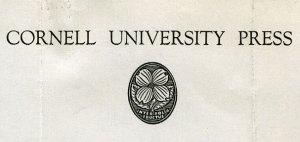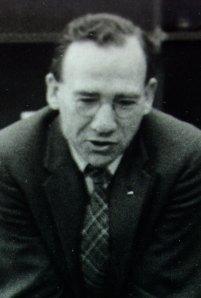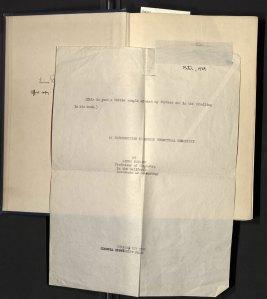
[Celebrating the 75th anniversary of The Nature of the Chemical Bond. Part 4 of 6.]
Once Linus Pauling began to send in the manuscript chapters of The Nature of the Chemical Bond to the Cornell University Press, the next step was to get the text formally approved by the Press’s board of directors and to find a printer. As it turned out, these tasks were not simple ones to achieve. First Pauling needed to deliver a complete manuscript that could be approved by the board. Pauling’s Caltech colleague Eddie Hughes helped him by staying in Ithaca, serving as an intermediary with the Press and making last minute changes to the manuscript, as directed by Pauling from Pasadena.
Hughes was finally able to hand over a finished product to W. S. Schaefer at the Cornell Press on July 5th, 1938. A quick turnaround to print looked dicey however as, according to Hughes, “it was the seventh book they’ve had ready for press in the past three weeks.” Schaefer promised Hughes that “the typescript would be in the printer’s hands at least before August 15,” but “it will be impossible to have the book before November 1 at the very earliest.” This timeframe was further interrupted in late July when Schaefer broke his knee and needed to be hospitalized. Hughes, for his part, had done all that he could and so made his way to Pasadena at the end of August.
It didn’t take long for Pauling to get anxious. On September 9th he wrote to both Schaeffer and his other main Cornell contact, Jacob Papish, asking for any word on his book’s progress, as he wanted to use it for one of his courses in the upcoming academic year. Schaefer responded apologetically, informing Pauling about his knee and how “the manuscript was received too late for publication this fall” because, over the summer when the book had arrived, “it was no longer possible to assemble our Committee on Publication.” The committee was scheduled to meet within the next week, and Schaefer assured Pauling that he would “rush” publication as much as possible.
Pauling did not take this news well, and he immediately wrote back to Schaefer that he had only just heard of this delay due “to the failure of your Committee on Publication.” Pauling was even more forthright with Papish, blaming Schaefer for “still holding up the printing until this Committee meets” and calling the potential two and a half month delay “inexcusable.” Overlooking his own earlier delays in getting the manuscript compiled, Pauling wrote, “if I had known at the beginning of the summer that this delay was contemplated, I might have done something about it.”
Papish tried to direct Pauling’s ire away from Schaefer, telling him “the [delay] was not due to inefficiency or procrastination on the part of Mr. Schaefer but to the organization of the University Press” which, being composed of professors, “is not very active during the summer.” With this, Pauling seems to have accepted the book’s fate, as he adjusted his own course schedule to incorporate the delayed publication. He also began explaining to others that his book might not be out until January, a date that, as it turned out, he would have to continually push back.

Eddie Hughes in 1957. Hughes played an important role in the publication of the Nature of the Chemical Bond and became a valued colleague of Pauling’s in the years that followed.
With the book in press by the first half of November 1938, Pauling began to send in revisions to Schaefer since “the unexpected delay of three months has caused the book to be somewhat out of date in places.” Schaefer was glad to include them, telling Pauling that doing so would delay the galley proofs somewhat, but that this loss “will be made up later.” Pauling started receiving, correcting, and returning the galleys to Schaefer by the end of December. After getting through the first four chapters, Schaefer suggested that Pauling send the corrected galleys directly to the printer in Wisconsin, in order to speed things up.
In January 1939, with the process moving along, Pauling began receiving more and more inquiries on the whereabouts of his book. Pauling had to tell sellers looking to stock his book and professors looking to use it in their courses that they would all have to wait – the initial word was that it would be ready in March, which quickly became April. During this time, Pauling also decided to add a twelfth chapter, (“A Summarizing Discussion of Resonance and its Significance for Chemistry”) suggesting to Schaefer that he prepare it for print without sending him the galleys to correct. Pauling still hoped to have the book ready for at least part of his course.
Since all of the galleys had been returned by the end of January, Pauling was expecting the page proof to arrive by the end of February. When this did not happen, Pauling began to get agitated again, reminding Schaefer that he was “being inconvenienced this year in teaching my class here because of lack of the book.” The page proofs started to arrive at the end of March and order arrangements were made for the Caltech bookstore, but interferences kept arising – now an influenza epidemic had rendered the printer short-handed. Schaefer told Pauling that “they are doing their utmost to complete your book,” but they did not want to “risk using inexperienced men for this difficult task.” As Schaefer’s letter was en route, Pauling, responding to an earlier request to shorten his preface, had the Press add Eddie Hughes to the list of individuals thanked for helping him put the book together. In this same letter, Pauling asked Schaefer to remove the printer from those so acknowledged.

The first edition office copy of The Nature of the Chemical Bond, containing Peter Pauling’s (age 8) typed annotation.
In mid-April, Pauling returned the final proofs, correcting any leftover spelling mistakes, and soon followed up with author and subject indices. Pauling also wanted to negotiate the price of the book. Forgetting that he had earlier expected it to sell for one cent per page, Pauling suggested that the 430-page book be priced at three dollars, but no more than three dollars and fifty cents. Schaefer told Pauling that this price was not possible, partly due to the special mathematical and chemical notation required by the book. Additionally, previous books in the Baker Lecture series had been published through the chemistry department at Cornell which had “rather lush” funding. The series was now fully under purview of the University Press and, as such, the selling price needed to cover production costs. Schaefer suggested four dollars and fifty cents, knowing that the Press would not garner the full price on most sales because of discounts afforded to educational organizations, booksellers, and foreign distributors. Pauling accepted Schaefer’s suggestion of four dollars fifty cents; mostly he was anxious to get the book printed.
On May 8th, Schaefer wrote to Pauling that, at last, the day had come – The Nature of the Chemical Bond was finally being printed, nearly six months after the original date proposed. Nonetheless, the books that Pauling ordered for his students did not reach Caltech until May 29th. Pauling told Schaefer this “was during the last of my lectures for the year, so that it turned out that the students were not able to use it very much in connection with my course.”

The same first printing containing Pauling’s notes for revision.
